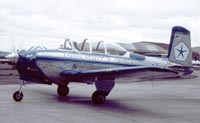 A
Concise History of the
A
Concise History of the
Beechcraft T-34 Mentor
By Norm Filer
The Beechcraft T-34 Mentor had a long and somewhat difficult birth. At the end of WWII there were enough surplus trainers in the U. S. military to just about give every GI his own airplane. And the requirement to train new pilots was declining just about as fast as the post war military budget. The only people interested in new military airplanes were those building and trying to sell them. Beechcraft was in about the same situation as all the rest of them; If they didn't sell something pretty quick, they were out of business. Beechcraft had done much better than many, they had the new and successful A-35 Bonanza on the market and were doing OK. But what they really needed was a military order to keep things moving.
Walter Beech felt there was a need for a new trainer and proceeded with the company funded prototype designated Beehcraft model 45. It shared the same landing gear, wings and a large portion of the fuselage with its civilian brother, the Beechcraft A35 Bonanza. One thing it did not share was the Bonanza's V tail. The design and marketing folks speculated that the targeted military were too conservative for anything that different. But the more conventional tail surfaces bore a striking resemblance to the Bonanza's.
Three were built and all were completed during 1948. After a series of competitions, contract awards to others that were never completed and inter service rivalry, the Korean War stopped the whole process.
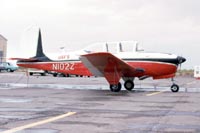 T-34A
T-34A
With the war winding down, the Air Force awarded Beechcraft a contract for the T-34A Mentor in 1952. Deliveries started in late 1953. An interesting side note is that in addition to Beechcraft, the Canadian Car and Foundry built 100 Mentors. About a quarter of these went to the Canadian armed forces and eventually found their way to Turkey.
The Air Force did not stay with the Mentor very long. By 1961 they were
rapidly moving toward an all jet training program. The Cessna 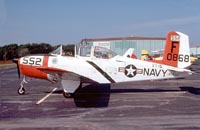 T-37
was rapidly replacing the T-34 as the primary trainer.
T-37
was rapidly replacing the T-34 as the primary trainer.
T-34B
The Navy, also now in the market for a new primary trainer, found the
Mentor fit their needs quite well, but still dictated some minor changes
to meet their unique needs. The most noticeable external difference is
the deletion of the small triangular fairing below the rudder. While the
Navy was the second T-34 customer, they became it biggest user. 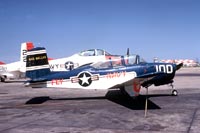 They
built over 400 of them between 1954 and 1958.
They
built over 400 of them between 1954 and 1958.
(In addition to the USAF and the USN, several foreign countries flew both the T-34A and T-34B, including Argentina, Chile, Colombia, El Salvador, Japan, Mexico, Peru, Philippines, Spain, Turkey, Uruguay and Venezuela. Ed.)
T-34C
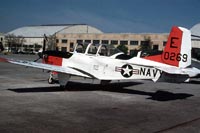 The
Navy was much slower adopting the all jet concept, but the trend was obvious.
In 1973 a contract was awarded to convert two T-34Bs to turbojet power.
Beechcraft made an excellent choice in powerplants , choosing the P &
W PT-6. The two test articles were designated YT-34C. After considerable
testing and some initial concerns about spin recovery the Navy eventually
bought a total of 334 T-34Cs.
The
Navy was much slower adopting the all jet concept, but the trend was obvious.
In 1973 a contract was awarded to convert two T-34Bs to turbojet power.
Beechcraft made an excellent choice in powerplants , choosing the P &
W PT-6. The two test articles were designated YT-34C. After considerable
testing and some initial concerns about spin recovery the Navy eventually
bought a total of 334 T-34Cs.
A quick look at the T-34C gives the impression that it is just a T-34B
on steroids. Actually there was considerable change. As mentioned above,
the A and B versions 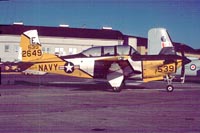 are
based on the A35 Bonanza. The T-34C kept the fuselage and canopy, but
the wings now came from the twin engined Beech Baron. Other components
were donated by the Beech Duke. With over twice the horsepower, the tail
surfaces were also enlarged and strakes and fillets added. When done it
still had a strong family resemblance, but was a very different bird.
are
based on the A35 Bonanza. The T-34C kept the fuselage and canopy, but
the wings now came from the twin engined Beech Baron. Other components
were donated by the Beech Duke. With over twice the horsepower, the tail
surfaces were also enlarged and strakes and fillets added. When done it
still had a strong family resemblance, but was a very different bird.
(Like the earlier T-34s, the T-34C found its way into foreign service, including Argentina, Ecuador and Morocco. Ed.)




